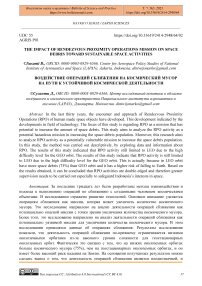The impact of rendezvous proximity operation mission on space debris toward sustainable space activities
Автор: Susanti Dini
Журнал: Бюллетень науки и практики @bulletennauki
Рубрика: Науки о земле
Статья в выпуске: 3 т.7, 2021 года.
Бесплатный доступ
In the last thirty years, the encounter and approach of Rendezvous Proximity Operations (RPO) of human made space objects have developed. This development indicated by the developments in field of technology. The focus of this study is regarding RPO as a mission that has potential to increase the amount of space debris. This study aims to analyze the RPO activity as a potential hazardous mission in increasing the space debris population. Moreover, this research aims to analyze RPO activity as a potentially vulnerable mission to increase the space debris population. In this study, the method was carried out descriptively, by exploring data and information about RPO. The results of this study indicated that RPO activity still limited to LEO due to the high difficulty level for the GEO orbit. The results of this study indicate that RPO activity is still limited to LEO due to the high difficulty level for the GEO orbit. This is actually because in LEO orbit have more space debris (75%) than GEO orbit and it has a higher risk of falling to Earth. Based on the results obtained, it can be concluded that RPO activities are double-edged and therefore greater supervision needs to be carried out especially to safeguard Indonesia’s interests in space.
Rpo, space object, space debris, geo orbit
Короткий адрес: https://sciup.org/14120915
IDR: 14120915 | УДК: 55 | DOI: 10.33619/2414-2948/64/02
Список литературы The impact of rendezvous proximity operation mission on space debris toward sustainable space activities
- Goodrich, M. K., Buchalter, A. R., & Miller, P. M. (2012). Toward a history of the space shuttle.
- Brunner, A. F. (2007). Spacecraft Proximity Operations Used to Estimate the Dynamical & Physical Properties of a Resident Space Object.
- Rekleitis, I., Martin, E., Rouleau, G., L'Archevêque, R., Parsa, K., & Dupuis, E. (2007). Autonomous capture of a tumbling satellite. Journal of Field Robotics, 24(4), 275-296. https://doi.org/10.1002/rob.20194
- Pearson, J., Levin, E., Oldson, J., & Carroll, J. (2010). Electrodynamic debris eliminator (edde): design, operation, and ground support. STAR TECHNOLOGY AND RESEARCH INC MOUNT PLEASANT SC.
- Schildknecht, T. (2007). Optical surveys for space debris. The Astronomy and Astrophysics Review, 14(1), 41-111. https://doi.org/10.1007/s00159-006-0003-9
- Jaramillo, L., & Weber, A. (2013). Bond yields in emerging economies: it matters what state you are in. Emerging Markets Review, 17, 169-185. https://doi.org/10.1016Zj.ememar.2013.09.003
- Keating, S. E., Machan, E. A., O'Connor, H. T., Gerofi, J. A., Sainsbury, A., Caterson, I. D., & Johnson, N. A. (2014). Continuous exercise but not high intensity interval training improves fat distribution in overweight adults. Journal of obesity, 2014. https://doi.org/10.1155/2014/834865
- Furfaro, R., Gaudet, B., Wibben, D. R., Kidd, J., & Simo, J. (2013). Development of nonlinear guidance algorithms for asteroids close-proximity operations. AIAA Guidance, Navigation, and Control (GNC) Conference, 4711. https://doi.org/10.2514/6.2013-4711
- Goodman, J. L. (2006). History of space shuttle rendezvous and proximity operations. Journal of Spacecraft and Rockets, 43(5), 944-959. https://doi.org/10.2514/L19653
- Hale, W., & Lane, H. W. (Eds.). (2010). Wings in orbit: scientific and engineering legacies of the Space Shuttle 1971-2010. Government Printing Office.
- Kelly, J. (2005). Debris Is Shuttle's Biggest Threat. Fla. Today.
- Nishida, S. I., Kawamoto, S., Okawa, Y., Terui, F., & Kitamura, S. (2009). Space debris removal system using a small satellite. Acta Astronautica, 65(1-2), 95-102. https://doi.org/10.1016/j. actaastro.2009.01.041
- Nikanpour D. (2009). Space Debris Mitigation Technologies.
- Johnson, N. L. (2010). Orbital debris: the growing threat to space operations.
- Krepon, M., & Thompson, J. (2013). Anti-satellite weapons, deterrence and Sino-American space relations. Naval postgraduate school Monterey CA center on contemporary conflict.
- Dhanji, N. (2002). Prospects for Involvement in Space Activities in Developing Countries via Small Satellites. Smaller Satellites: Bigger Business? 307-314. Springer, Dordrecht. https://doi .org/10.1007/978-94-017-3008-2_35
- Pavek, M., & Stephenson, R. (2002). Report on Panel Discussion 4: Launch and Support Services for Micro/Nanosatellites. Smaller Satellites: Bigger Business? 267-268. Springer, Dordrecht, https://doi.org/10.1007/978-94-017-3008-2_30
- David, L. (2013). Mysterious Actions of Chinese Satellites Have Experts Guessing. Space. com, 9.
- Wall, M. (2014). Is Russian Mystery Object a Space Weapon? Space. com, 19.
- Perek, L. (2012). Actual Situation in the Geostationary Orbit. Proceedings of the Institute of International Space Law, Eleven International Publishing, The Hague.
- Dougherty, K. (2014). Crowded space: The problem of orbital debris. Issues, (106), 18. https://search.informit.org/doi/10.3316/informit.497113170613249
- Rahayu, M. (2007). Pendidikan kewarganegaraan. Grasindo.
- Pramono, A. (2011). Dasar-dasar hukum udara dan ruang angkasa. Ghalia Indonesia.
- Diederiks-Verschoor, I. H. (2008). An introduction to space law.
- Chen, X., Xiang, S., Liu, C. L., & Pan, C. H. (2014). Vehicle detection in satellite images by hybrid deep convolutional neural networks. IEEE Geoscience and remote sensing letters, 11 (10), 1797-1801. https://doi.org/10.1109/LGRS.2014.2309695
- Hsu, J. (2014). Global Conflict Could Threaten Geostationary Satellites. Scientific American, 31.
- Finkleman, D., & Oltrogge, D. (2002, January). Consequences of Debris Events in Geosynchronous Orbit. AIAA/AAS Astrodynamics Specialist Conference and Exhibit, 7375. https://doi.org/10.2514/6.2008-7375
- Benedict, B. L. (2013). Rationale for need of in-orbit servicing capabilities for GEO spacecraft. AIAA SPACE 2013 Conference and Exposition, 5444. https://doi.org/10.2514/6.2013-5444
- Barnhart, D., Sullivan, B., Hunter, R., Bruhn, J., Fowler, E., Hoag, L. M., ... & Vincent, K. (2013). Phoenix program status-2013. AIAA SPACE 2013 conference and exposition, 5341. https://doi.org/10.2514/6.2013-5341


